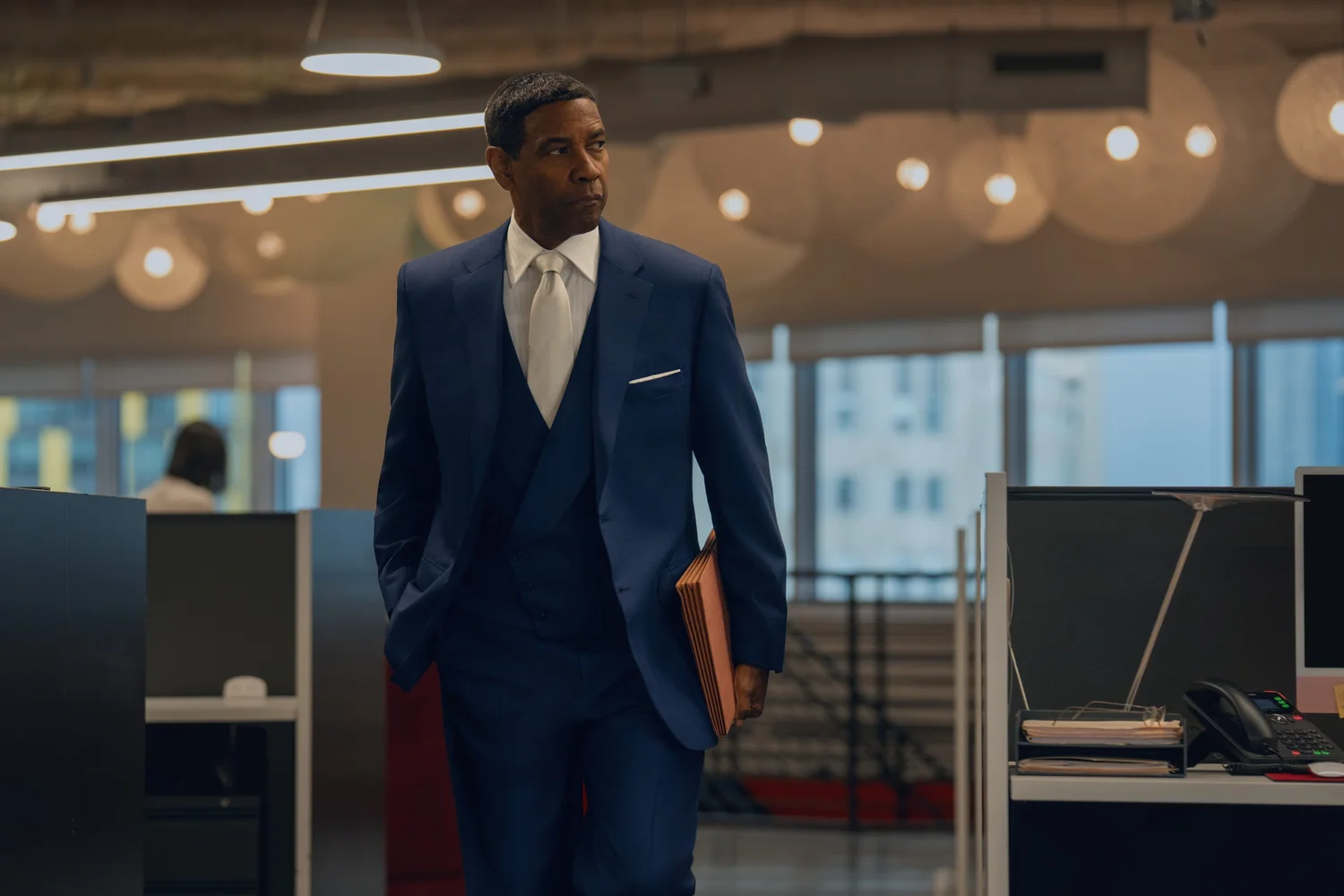Images courtesy of A24
HIGHEST 2 LOWEST— 4 STARS
Nonconformist to a hilt, Spike Lee can take any source material, time period, or genre—from Greek theater and urban crime to notable biographies and acclaimed history—and make it all his own. Between his signature stylistic flourishes and incendiary thematic infusions, Spike Lee’s flair of exceptionality is what makes him one of the best and boldest storytellers of his generation. Dare him to take a run at Akira Kurosawa, return the incomparable Denzel Washington to his call sheet, and watch his cup, and ours, runneth over with Highest 2 Lowest.
Lee’s latest film, scripted by actor Alan Fox, is billed as a modern interpretation of Akira Kurosawa’s highly revered 1963 classic High and Low (coming to the Criterion Collection this September), which was loosely based on the 1959 crime novel King’s Ransom, the tenth book of Ed McBain’s 87th Precinct Mysteries series. Living in his lavishly appointed high-rise penthouse overlooking the Brooklyn Bridge to Manhattan is renowned music executive David King (Washington). He is one of the top board members of Stackin’ Records, a label he established and defined with his ear for talent and tenacity for the music itself. King is married to a fellow businesswoman, Pam (Ilfenesh Hadera, working with Lee for the fourth time across film and television), and the two share a teenage son, Trey (Aubrey Joseph of Cloak and Dagger), who someday wants to join his father’s business.
LESSON #1: “ALL MONEY AIN’T GOOD MONEY”— Stackin’ Records and King enjoyed massive success in the 1990s and 2000s before the digital revolution splintered the industry and talent pool. Now, the dwindling label is facing a buyout from a financial holding company sure to sell it off for parts, evaporating David’s legacy. As David likes to tout, “All money ain’t good money.” He doesn’t want to see the music—and Black culture itself—squeezed out by changes in the business like AI programming soulless music. Even if he’s feeling the push to put family first and accept the golden parachute of stepping away, there’s a prideful spine inside him to change his mind about the deal, revealing a personal righteousness for what he’s built in Highest 2 Lowest.
After he and his driver, long-time friend and ex-con Paul Christopher (Academy Award nominee Jeffrey Wright), drop Trey and his godson Kyle (newcomer Elijah Wright) off for at a Long Island University basketball camp coached by Rick Fox (playing himself), David approaches his fellow Stackin’ Records board member, Patrick Bethea (Michael Potts of Ma Rainey’s Black Bottom), about personally buying out his shares to increase his controlling interest enough to block the impending sale. After a sit-down and a handshake, David and Patrick agree to the internal move.
All of the financial gears are moving according to plan when David receives an ominous, unknown phone call that his son has been kidnapped. He and Pam immediately bring in the authorities, led by a trio of NYPD detectives (theater actor John Douglas Thompson, multiple Tony winner LeChanze, and Allstate Insurance’s “Mayhem” himself, Dean Winters) who take point. The kidnapper (rapper ASAP Rocky, unseen for the first half of Highest 2 Lowest) demands a $17.5 million ransom, a sum that would virtually gut King and negate the deal to keep his company.
The perpetrator’s inflexibility in negotiation and scornful personal stance against David King increase the tension. As this happens, Highest 2 Lowest matches the instigating twist of Kurosawa’s film when Trey returns home safely, revealing that Paul’s son Kyle was kidnapped by mistake instead of him. With his own flesh-and-blood no longer at risk, the moral and financial dilemma to save Kyle weighs on David next.
LESSON #2: INTEGRITY OVER MONEY— Like Kurosawa, Lee raises the question of a rich man’s responsibility for a kidnapper’s mistake in Highest 2 Lowest. David King has the means to save an innocent life—his own godson and a young man considered part of the family with Paul—yet it would lead to crippling financial ruin. Both alone in his study and engaged with peers he trusts above the cops, Denzel Washington’s penchant for internal turmoil plays out the Scrooge-esque temptation of miserly defiance against paying the ransom altogether. It takes a heart-to-heart with the spared Trey, who has measured the fallout of public perception and challenges his father’s decency, for David to agree to choose integrity over money to pay the ransom for Kyle, setting into motion the police pursuit chapter of Highest 2 Lowest.
In many ways, Highest 2 Lowest improves upon the source novel and original film adaptation. The boost in age of the dangled children from precocious grade school playmates to able-bodied teens, along with Jeffrey Wright’s increased gravitas in the key chauffeur role, grants a benefit of agency and danger. No offense to Kurosawa and his collaborating screenwriters, Hideo Oguni, Ryūzō Kikushima, and Eijirō Hisaita, but the 21st-century music business has far more sizzle than the boardroom dealings of a shoe factory in post-war Japan. That selected backdrop allows Spike Lee to fully envelop his movie with a proud Black persepective—covering nearly every corner of the King home in artifacts and homages—and activate a celebration of New York City’s multi-burough melting pot of culture, culminating with the money drop scene weaving its way suspensefully through the chaos of a busy baseball crowd (enjoy the good luck charm appearance of Nicholas Turturro) on the subway to Yankee Stadium and parading Puerto Ricans of the Mott Haven neighborhood (complete with dignitary cameos from Rosie Perez and Anthony Ramos).
While Spike Lee retains the aforementioned central motivator of character integrity for Highest 2 Lowest, where he chooses to deviate from High and Low reveals his favoritism and hubris, all with varying effectiveness. Darren Aronofsky’s go-to cinematographer and three-time Academy Award nominee, Matthew Libatique, imparts Lee’s floating visual movement and playful changes of film grain, especially with boom, jib, and tilt moves to push and lift viewpoints higher, with fluidity different from the masterful blocking many compliment about Kurosawa’s picture. By far, the weakest brushstroke from Lee is a curiously frilly musical score from composer Howard Drossin, which plays in the same overbearing and tawdry soap opera realm as when Todd Haynes borrowed old and ill-fitting Michel Legrand cues for May December. Luckily, Spike provides a crack soundtrack of song inclusions that make up for the missing punch that used to come from the towering talent of Terence Blanchard and his piercing trumpet.
Where Akiro Kurosawa passed the baton from Toshiro Mifune’s lead exec to the procedural work of the detective team for the meaty middle and climax of his film—a revelatory move which highlighted intelligent detail for 1963—Highest 2 Lowest fast-fowards or sidesteps the methodical investigation route for more bravado. Despite theatrical powerhouses like Thompson and LeChanze at his disposal, Lee and Alan Fox only shallowly delve into wrinkles possible from today’s advancements of surveillance technology and burdensome media coverage for a crime on this level, in favor of keeping the Oscar-winning legend front and center.
LESSON #3: WHO’S THE MAN?— In line with his career constant of playing take-charge men, Denzel Washington never leaves the golden glow of Highest 2 Lowest. Choosing to confront his kidnapper directly with vigilante-level gall, Washington collides with ASAP Rocky in scenes crackling with intensity and energized by an impromptu rap battle showdown, their chosen language for sizing each other up as threats. Working with Spike for the fifth time and first since 2006’s Inside Man, Denzel is in his imposing element, and that will always be a pleasure to behold. The movie could have been two hours of the young cub stepping to the old lion, and we would still be enraptured, Kurosawa homage or otherwise.
LESSON #4: THE AUDACIOUSNESS OF SPIKE LEE— Earlier, the verb “dare” was used to describe Spike Lee’s endeavor to remake Akira Kurosawa, and the audacity of it all is quite fitting. Sure, the creatively bankrupt and often careless Hollywood machine has pulled from and diluted the few-against-many cores of Seven Samurai and Yojimbo and the multiple perspectives tricks of Rashomon for decades. High and Low, with its discourse on social classes, was a different animal entirely, yet one perfectly suited for Spike Lee’s rebellious cinematic megaphone. Here he is, worthy as a master in his own right and united with his greatest and quintessential muse, going so far as adding the -est modifier to the title to appropriately aim for the topmost effect possible and play right along into the modern age of hyperbolic buzz. “Attention is the only currency” is the juiciest line of the movie, and that couldn’t be more Spike Lee.
LOGO DESIGNED BY MEENTS ILLUSTRATED (#1332)



